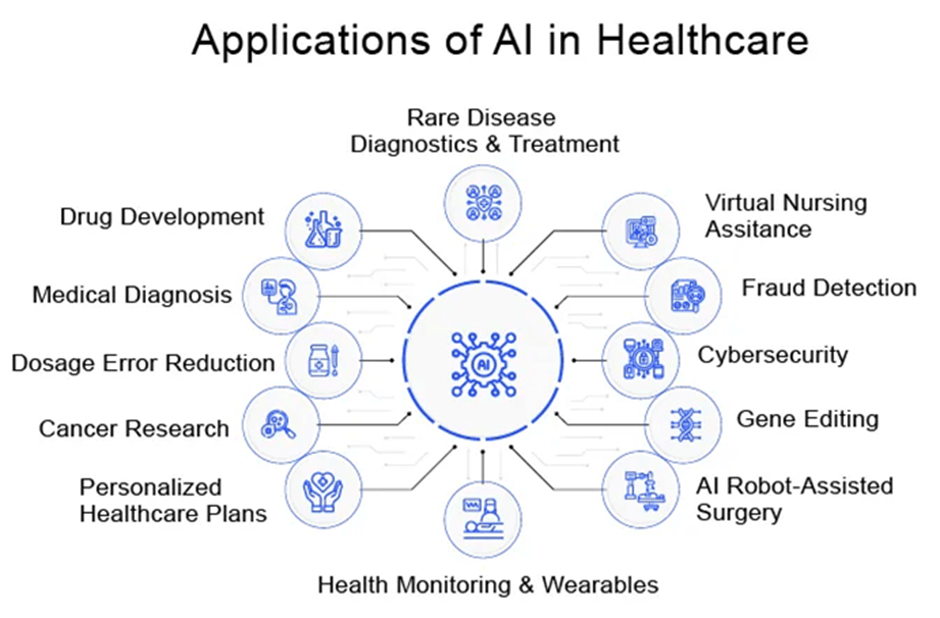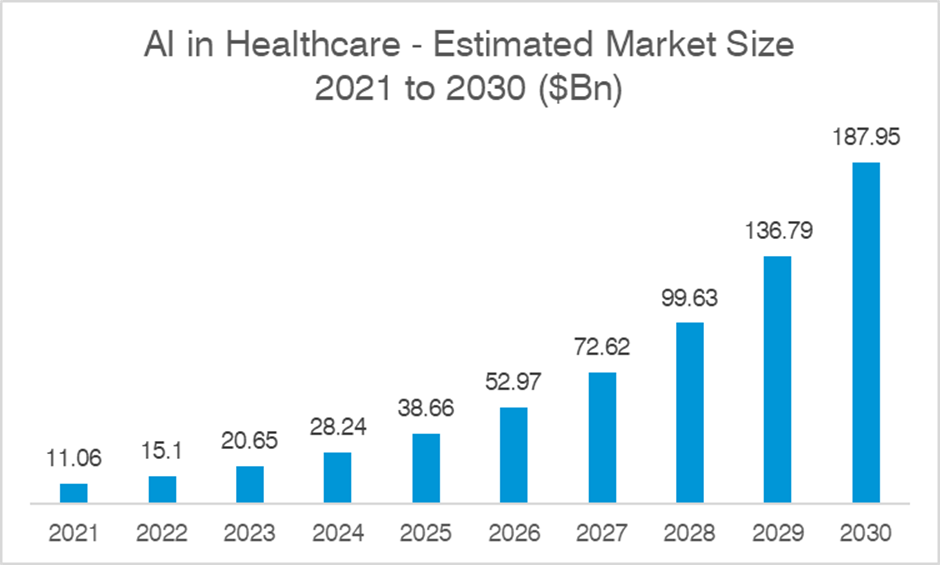For most, artificial intelligence (AI) is a fairly new phenomenon, yet it has been used within healthcare for almost 50 years. The sector creates a vast amount of data which can be leveraged using AI to enhance the quality, effectiveness and availability of care. GAM Investments’ Kevin Kruczynski examines its applications in healthcare and considers the companies that are becoming digital leaders.
17 August 2023
Click here to view the Disruptive Strategist Newsletter in full.

It is not a novel observation that technological evolutions often appear to take more time than initially anticipated, but when they do materialise, they seem to occur rapidly. This is attributable to the way technological advancements tend to compound, with each new development enabling even grander achievements. Over the last year or so, several stars aligned as advancements in algorithms, GPU technology and data accessibility enabled the launch of Chat-GPT. This propelled artificial intelligence (AI) into the limelight, sparking intense debate among investors, businesses and the broader public. While this appears to be an overnight phenomenon, many organisations have been labouring behind the scenes for decades to cultivate and harness potential applications.
Healthcare – an area for early AI adoption
This takes us to the healthcare sector, which has long been a promising area for early AI adoption, as it offers the promise to enhance the quality, effectiveness and availability of care. It is a setting that creates a tremendous volume of data, which can be employed to train AI systems to improve diagnosis, treatments and prevention. Healthcare professionals regularly make complex decisions based on incomplete information; AI models can analyse extensive data sets and offer valuable insights to assist the decision-making process. Rudimentary forms of AI have actually existed for decades, such as Stanford’s MYCIN, an early AI tool developed in 1972 for diagnosing blood infections. Computer assisted detection systems using AI algorithms to scrutinise medical images for potential irregularities emerged during the 1980s and 1990s, leading to significant changes in the field of radiography. AI has also been developed to plan and guide radiotherapy treatment, with the aim of minimising damage to healthy tissue and improving patient outcomes.
Given this context, it is no surprise that we find the disruptive healthcare companies within our portfolio are using AI to improve their product offering while helping to widen their technological moats.
Intuitive Surgical, the leading provider of robotic surgical systems, has been embedding AI to improve the accuracy and efficiency of its da Vinci systems for many years. For example, AI-powered image guidance can help surgeons see more clearly during surgery, with data overlayed across the field of view, and AI-powered decision support tools helping make better decisions. Its smart staplers can measure tissue compression and make automatic adjustments to the stapling process to ensure optimal placement, reducing the risk of complications. The system can monitor the patient during a procedure and update the operating plan to pre-empt any problems. With two decades of usage data, and over 12 million procedures already performed and recorded on its systems, Intuitive has a significant lead over any emerging peers in terms of data gathering and AI model training capability.
Omnicell is a market-leading provider of medication management solutions. The company is using AI to improve the accuracy and efficiency of its medication dispensing systems. For example, analytics tools can help hospitals to track medication inventory levels, identify potential drug shortages and support reducing the USD 600 billion medical mal-adherence problem. This is important as a considerable amount of time is spent managing medication shortages.
Dexcom, the leading maker of continuous glucose monitoring devices, uses AI to improve the accuracy of glucose readings and to personalise alerts and alarms to help patients understand and make better informed decisions to manage diabetes risks.
Oxford Nanopore develops nanopore sequencing technology that is faster, cheaper, and more portable than traditional DNA sequencing methods. It uses AI to make its technology more accurate, efficient, and powerful. Thanks in part to its AI data analysis algorithms, it has improved its system accuracy from 85% back in 2015 to above 98%. This improvement has made nanopore sequencing a more powerful and versatile tool for a variety of applications; for example, it is now being used to diagnose diseases, monitor environmental changes and develop new drugs.

We often emphasise the assertion that "data is the new oil” and that the further along a business is in its digital transformation, the more data it generates. This abundance of data will make it easier to transition into the AI age, in our view. Our healthcare companies are among the digital leaders in their respective fields and are therefore well placed to thrive in this era.
The information contained herein is given for information purposes only and does not qualify as investment advice. Opinions and assessments contained herein may change and reflect the point of view of GAM in the current economic environment. No liability shall be accepted for the accuracy and completeness of the information contained herein. Past performance is no indicator of current or future trends. The mentioned financial instruments are provided for illustrative purposes only and shall not be considered as a direct offering, investment recommendation or investment advice or an invitation to invest in any GAM product or strategy. Reference to a security is not a recommendation to buy or sell that security. The securities listed were selected from the universe of securities covered by the portfolio managers to assist the reader in better understanding the themes presented. The securities included are not necessarily held by any portfolio nor represent any recommendations by the portfolio managers nor a guarantee that objectives will be realized.
This material contains forward-looking statements relating to the objectives, opportunities, and the future performance of the U.S. market generally. Forward-looking statements may be identified by the use of such words as; “believe,” “expect,” “anticipate,” “should,” “planned,” “estimated,” “potential” and other similar terms. Examples of forward-looking statements include, but are not limited to, estimates with respect to financial condition, results of operations, and success or lack of success of any particular investment strategy. All are subject to various factors, including, but not limited to general and local economic conditions, changing levels of competition within certain industries and markets, changes in interest rates, changes in legislation or regulation, and other economic, competitive, governmental, regulatory and technological factors affecting a portfolio’s operations that could cause actual results to differ materially from projected results. Such statements are forward-looking in nature and involve a number of known and unknown risks, uncertainties and other factors, and accordingly, actual results may differ materially from those reflected or contemplated in such forward-looking statements. Prospective investors are cautioned not to place undue reliance on any forward-looking statements or examples. None of GAM or any of its affiliates or principals nor any other individual or entity assumes any obligation to update any forward-looking statements as a result of new information, subsequent events or any other circumstances. All statements made herein speak only as of the date that they were made.
